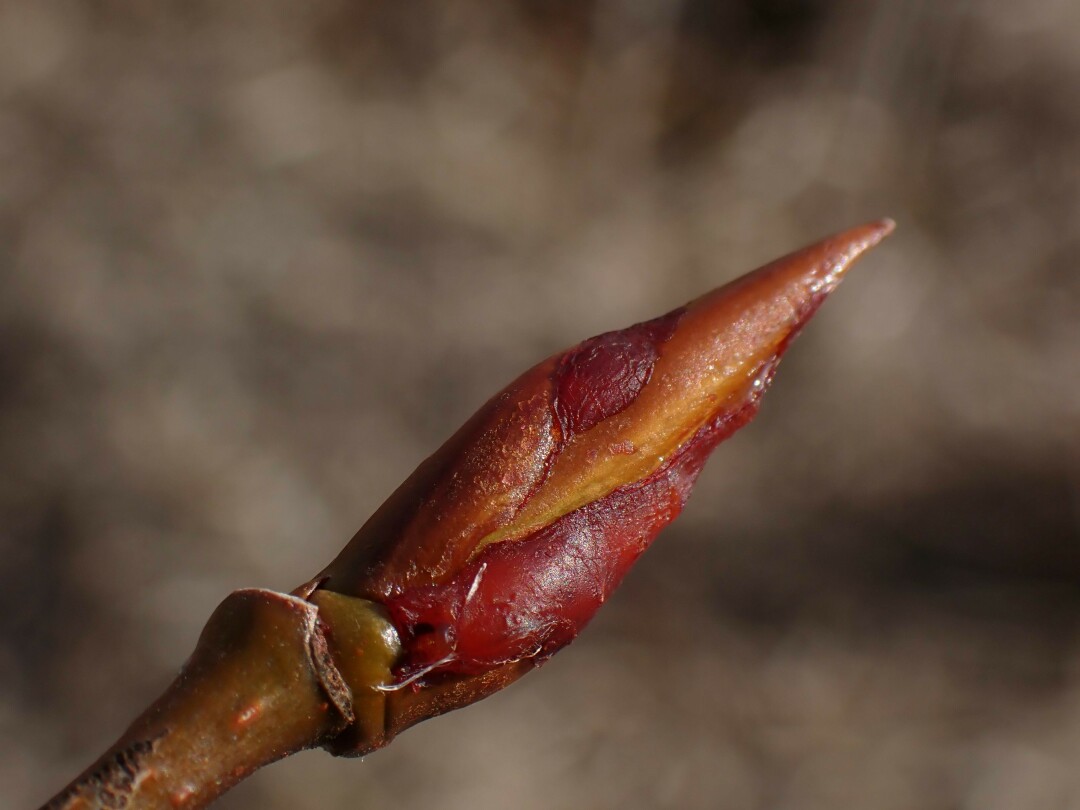News & Articles
Browse all content by date.

The buds of a balsam poplar tree are coated in sticky, aromatic resin that contains medicine for both the trees and us. Photo by Emily Stone.
We were supposed to be focused on birds as the group walked along the gravel road north of Grandview, but in the damp air I smelled something. Thick, sweet and spicy, the scent hung in this one spot where tall trees gathered instead of the scrubby alder brush. I inhaled deeply, filling my lungs with an aroma that reminded me of lovingly cooked food, or carefully chosen perfume, or new life. I couldn’t quite place it.
Looking around the small patch of forest, I noticed olive-green bark near the top and gray-brown furrows at the bottom. Aspen, I thought.
But wait. On a hunch, I jumped a wet spot in the ditch to get a better look at some lithe young twigs sprouting out of an injury in the base of one of the trees. The buds were almost an inch long and encased in shiny brown scales just beginning to expand. I pinched one, and the aroma intensified.
Another birder walking near me looked curious, so I broke off the bud and handed it to her. “Hmmm…Oh!” she exclaimed as she caught the scent, too.
The buds of balsam poplar were releasing their magic.
In Wisconsin, Populus balsamifera aren’t as common as their cousins the quaking and big-tooth aspens. Their numbers increase as you head north, and their groves catch my eye with a distinctive golden cast to leaves and bark whenever I head up Scenic Highway 61 along the North Shore of Lake Superior. Reaching peak performance on the damp soil and extreme cold of Alaskan and Canadian floodplains, balsam poplars survive the farthest north of any American broadleaf tree.
Similar to a big-tooth aspen, balsam poplars have pale young bark and furrowed older bark. The leaves, though, have finely serrated teeth and rusty blotches on the undersides. Their winter buds, as we noticed, are reddish brown, up to an inch long, and glossy.
As spring sunshine coaxes open the buds, that gloss becomes airborne. According to scientist Diana Beresford-Kroeger (“The Jane Goodall of trees,”) those aerosols act like “a health shield for all life on the planet.” The aromas wafting in the breeze contain a myriad of chemicals. They are anti-inflammatory, anti-bacterial and anti-fungal. Often included in wild-crafted soaps and salves, balsam poplars have earned the nickname “Balm of Gilead,” after a rare, medicinal perfume mentioned in the Hebrew Bible.
The more scientists dig into the chemistry of balsam poplar, the more impressive it gets. In the poplar’s pharmacopeia, scientists have identified vasodilators that are important for heart health, and oxytocins that reduce blood pressure. These trees of the far north manufacture the molecular building blocks of the brown fat that humans use to shiver and stay warm.
Tree bodies contain the same chemicals that the human body deems essential for brain, liver and glandular development.
For years the Cree Nations have used balsam poplar sap to treat diabetes, and now scientists are expanding on that traditional knowledge. An article in the international, peer-reviewed journal of Evidence-Based Complementary and Alternative Medicine states “The results clearly demonstrated that the plant extract substantially attenuated weight gain and the development of insulin resistance [in mice].”
In fact, balsam poplars, who belong to the Willow Family, Salicaceae, have seemingly figured out the key to eternal life. Roots, stumps, and even stems and branches buried during autumn logging can sprout into whole new trees. Even 15-year-old cuttings regularly sprout new roots and shoots when planted in damp soil.
Each spring, balsam poplar produces thousands of tiny seeds attached to silky parachutes – they are often called cottonwood like their southern cousins – but they mainly rely on vegetative reproduction, not those seeds.
So where do these trees get their super powers? Unlike the northern conifers, balsam poplars have taproots that dive deep into the soil, right down to the nutrient-rich permafrost layer (wherever there is one). The tree draws up minerals, concentrates them into the waxy green leaves, and generously drops them onto the ground every fall. This enriches the topsoil for all the neighbors.
Beresford-Kroeger suspects that these habits, and their pharmacopeia, are all adaptations to surviving the harsh environment of the cold, dry North. Somewhat ironically, this cold-adapted tree may win bigtime as the climate changes – at least for a while.
As summers warm and lengthen, balsam poplars are intruding on formerly treeless areas at the northern end of their range. They are making fundamental changes in the tundra. In a journal article from 2016, Carl A. Roland (the botanist I studied with in Denali when I visited Alaska!) and his colleagues from the National Park Service declared, “It appears that poplar may thus act as the ‘leading edge’ of landscape change in this region…leaving a substantially altered, boreal landscape in its wake.”
Meanwhile, they will disappear from the southern end of their range – like the gravel road near Grandview, Wisconsin.
That’s a lot to take in on a damp spring day.
Emily’s award-winning second book, Natural Connections: Dreaming of an Elfin Skimmer, is available to purchase at www.cablemuseum.org/books and at your local independent bookstore, too. For more than 50 years, the Cable Natural History Museum has served to connect you to the Northwoods. Our new exhibit: “The Northwoods ROCKS!” is open now! Our Summer Calendar of Events is ready for registration! Follow us on Facebook, Instagram, YouTube, and cablemuseum.org to see what we are up to.
| Tweet |


